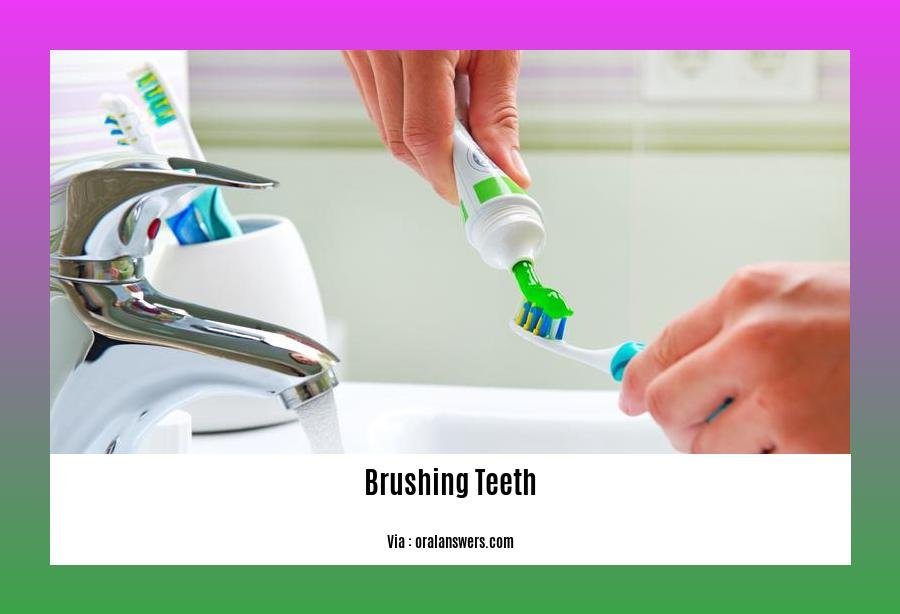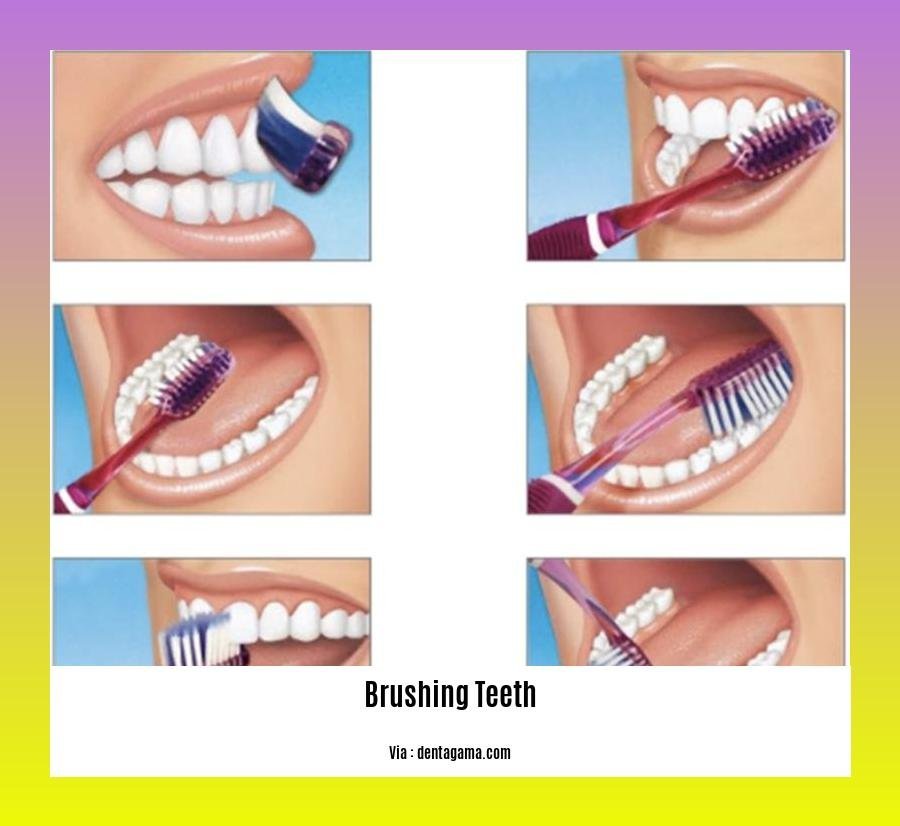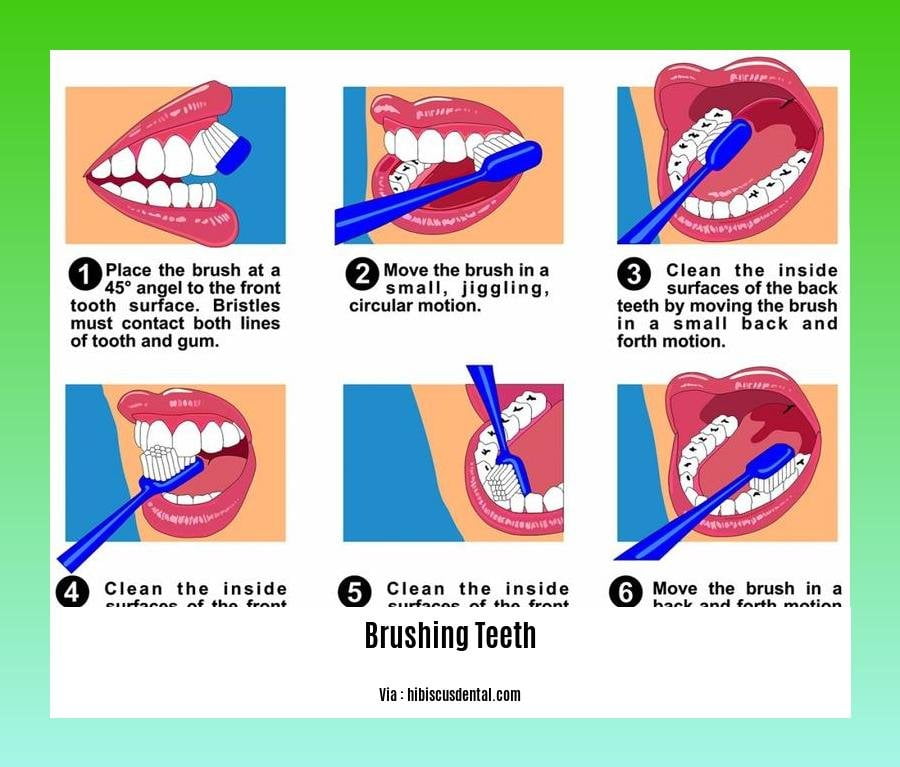Discover the ultimate guide to brushing teeth and uncover the 10 essential facts that will revolutionize your oral hygiene routine. In this comprehensive article, we delve into the world of oral care to provide you with crucial insights on the importance of brushing teeth. As an experienced dental professional with a deep understanding of dental practices, I will share my expertise on the best techniques, advanced tools, and technologies to maintain optimal oral health. Get ready to upgrade your dental routine with these essential facts about brushing teeth.
Key Takeaways:
- Brushing teeth too hard or using teeth as tools can damage tooth enamel, the hardest substance in the human body.
- 40% of tooth surfaces are missed by not flossing regularly, with only 13.5% of Americans flossing daily.
- Rinsing after brushing can wash away the protective fluoride.
- Brushing teeth alone is insufficient to combat bad breath, brushing the tongue is necessary.
- Using whitening toothpaste excessively can erode tooth enamel.
- Toothbrushes can contain bacteria and can be contaminated by airborne particles from toilet flushing.
- Poor oral hygiene can lead to heart problems, as mouth bacteria can enter the bloodstream and cause inflammation.
- The average person only brushes for 45 to 70 seconds per day, while the recommended time is 2 to 3 minutes.
Facts About Brushing Teeth

Maintaining proper oral hygiene is essential for keeping your teeth and gums healthy. Brushing your teeth is a crucial part of this routine, but did you know that there are several interesting facts about brushing teeth that you may not be aware of? In this article, we will delve into the facts about brushing teeth to shed light on some important aspects that you may find surprising.
Fact 1: Tooth Enamel and Its Vulnerability
Tooth enamel is the hardest substance in the human body, even stronger than bone. However, it is not invincible. Surprisingly, tooth enamel can still be damaged by seemingly harmless actions like opening bottle caps or brushing too hard. So, it’s important to remember to be gentle while brushing to avoid any unnecessary erosion of this protective layer.
Fact 2: Flossing – A Missed Opportunity
While brushing your teeth is a good start, it’s not enough to ensure optimal oral health. Not flossing means missing out on cleaning as much as 40% of tooth surfaces. Shockingly, only 13.5% of Americans floss every day, indicating a significant missed opportunity in maintaining proper oral hygiene.
Fact 3: Rinse, But with Caution
We all know that rinsing after brushing helps to freshen our breath and leave a clean feeling in our mouths. However, did you know that by rinsing immediately after brushing, you might actually be washing away the fluoride that protects your teeth? To maximize the effectiveness of fluoride, it is recommended to wait at least 30 minutes after brushing before rinsing.
Fact 4: Tackling Bad Breath
Brushing your teeth alone may not be enough to combat bad breath. Neglecting to brush your tongue can harbor bacteria that contribute to unpleasant breath. To address bad breath effectively, make sure to incorporate tongue brushing into your oral hygiene routine.
Fact 5: Beware of Whitening Toothpaste
Many of us desire a bright, white smile and turn to whitening toothpaste to achieve it. However, be cautious with these products as they can potentially damage your teeth by eroding the enamel. If you want to whiten your teeth, it’s advisable to consult your dentist for professional guidance.
Fact 6: Bacteria on Your Toothbrush
Did you know that your toothbrush itself can be a breeding ground for bacteria? Airborne particles generated from toilet flushing can contaminate your toothbrush. It’s important to store your toothbrush in an upright position, away from the toilet area, and replace it every three to four months to maintain oral hygiene.
Fact 7: Oral Health and Heart Problems
Maintaining good oral hygiene is not only essential for healthy teeth and gums but also for your overall well-being. Poor oral hygiene can actually lead to heart problems. The bacteria in your mouth can enter the bloodstream and cause inflammation, ultimately impacting your cardiovascular health.
Fact 8: The Importance of Brushing Time
The average person spends only 45 to 70 seconds brushing their teeth each day, falling significantly short of the recommended time of 2 to 3 minutes. By cutting corners on brushing time, we may not be effectively removing plaque and maintaining our oral health. Therefore, it’s crucial to allocate sufficient time to thoroughly clean your teeth.
In conclusion, brushing your teeth plays a vital role in maintaining optimal oral health. However, there are several key facts about brushing teeth that may surprise you. From the vulnerability of tooth enamel to the importance of proper flossing techniques, these facts highlight the need for a comprehensive approach to oral hygiene. By incorporating these facts into your daily routine, you can ensure that your teeth and gums remain healthy and strong for years to come. Remember, it’s not just about brushing your teeth; it’s about understanding the facts and taking proper care of your oral health.
Are you interested in learning some fascinating facts about Brazilian food? Check out our page on facts about Brazil food and discover the delicious and diverse culinary traditions of this vibrant country. From exotic fruits to savory meat dishes, you won’t want to miss out on this mouthwatering adventure. So, don’t wait any longer, click on the link and let your taste buds take you on a virtual culinary journey through Brazil!
Different Types of Toothbrushes and Their Effectiveness

Key Takeaways:
- There are six main types of toothbrushes: manual, electric, disposable, travel, interdental, and chewable.
- When choosing a toothbrush, it’s important to consider the ADA Seal of Acceptance to ensure effectiveness.
- Both manual and electric toothbrushes can effectively clean teeth when used correctly.
- Soft bristles are recommended to effectively clean teeth without damaging the gums.
- Hard-bristle brushes can be more abrasive and may not be suitable for everyone.
- Some individuals may prefer medium-bristle brushes if they find soft bristles ineffective.
- The selection of a toothbrush should consider individual preferences and needs.
When it comes to brushing your teeth, the type of toothbrush you use plays a crucial role in maintaining good oral health. There are various types of toothbrushes available, each with its own advantages and effectiveness.
Manual Toothbrushes
Manual toothbrushes are the most common type and come in different shapes, sizes, and bristle types. They are readily available and affordable. You can choose a manual toothbrush based on your personal preference, whether you prefer a smaller or larger brush head, or soft or medium bristles.
Electric Toothbrushes
Electric toothbrushes are powered by batteries or electricity and come with a vibrating or rotating brush head. They are known for their ability to provide a deeper and more efficient clean. Many electric toothbrushes also have built-in timers to ensure you brush for the recommended two minutes.
Disposable Toothbrushes
Disposable toothbrushes are designed for one-time use and are convenient for travel or on-the-go situations. They often come pre-loaded with toothpaste, making them a convenient option when you don’t have access to your regular toothbrush.
Travel Toothbrushes
Travel toothbrushes are compact and portable toothbrushes specifically designed for traveling. They often come with a cap or case to keep the brush head clean during transportation.
Interdental Toothbrushes
Interdental toothbrushes are designed with small, narrow brush heads to clean between teeth and braces. They are ideal for reaching areas that regular toothbrushes may not be able to access, promoting better oral hygiene.
Chewable Toothbrushes
Chewable toothbrushes are specifically designed for children or adults who have difficulty using traditional toothbrushes. These brushes can be chewed to clean teeth effectively, making oral hygiene more accessible for individuals with limited dexterity.
When selecting a toothbrush, it is important to consider the effectiveness. The American Dental Association (ADA) recognizes both manual and electric toothbrushes as equally effective at removing plaque when used correctly. The key is to brush twice a day for two minutes with a fluoride toothpaste.
Choosing the right bristle type is equally important. Soft bristles are firm enough to clean teeth effectively without causing damage to the gums. It is advised to apply gentle pressure while brushing. On the other hand, hard-bristle brushes are more abrasive and can be useful for scrubbing away stains, but they may not be suitable for everyone. Some individuals may prefer medium-bristle brushes if they feel that soft bristles are not effective enough.
In conclusion, different types of toothbrushes offer various benefits and effectiveness. The selection of a toothbrush should take into account individual preferences, needs, and oral health conditions. The ADA Seal of Acceptance can guide you towards toothbrushes that meet necessary standards for effectiveness. Remember, maintaining optimal oral health is a vital part of overall well-being.
Sources:
– Learn the Types
– Mouth Healthy
The Role of Toothpaste and Mouthwash in Brushing
When it comes to brushing teeth, toothpaste and mouthwash play a vital role in maintaining optimal oral health. Let’s explore the importance of these two key components in your brushing routine.
Proper Brushing Technique
Before delving into the role of toothpaste and mouthwash, it’s crucial to establish the foundation of effective brushing technique. Remember to hold your toothbrush at a 45-degree angle to the gums and use gentle, circular motions to clean all tooth surfaces. Spend at least two minutes brushing, twice a day, to ensure thorough plaque removal.
The Role of Toothpaste
Toothpaste, especially those containing fluoride, plays a significant role in oral hygiene. Fluoride is absorbed by the teeth over time, making them stronger and more resistant to decay. Additionally, toothpaste helps remove plaque, clean and polish teeth, and freshen breath.
Choosing the Right Toothpaste
When selecting a toothpaste, consider one that contains fluoride. Fluoride toothpaste aids in remineralizing enamel attacked by acids, making it more resistant to decay. Personal preferences, such as flavor and sensitivity, should also be taken into account.
The Role of Mouthwash
While toothpaste provides essential benefits, mouthwash offers additional advantages in your oral care routine. Mouthwash can reach areas of the mouth that a toothbrush might miss, helping to further reduce plaque and freshen breath. It can also be beneficial for those with gum disease or other specific oral health concerns.
Choosing the Right Mouthwash
When choosing a mouthwash, look for one specifically designed to address your oral health needs. Whether it’s for freshening breath, reducing plaque, preventing cavities, or treating gum disease, there are different types of mouthwash available. Consult with your dentist to determine which mouthwash is most suitable for you.
Key Takeaways:
- Toothpaste with fluoride helps strengthen teeth and make them more resistant to decay.
- Proper brushing technique involves holding the toothbrush at a 45-degree angle and using gentle, circular motions.
- Mouthwash can further reduce plaque and freshen breath.
- Choose a toothpaste and mouthwash that meet your specific oral health needs.
- Consult with a dentist to ensure you are using the right products for your oral care routine.
Additional Sources:
- University of Rochester Medical Center. “Brushing and Toothpaste – Health Encyclopedia.” University of Rochester Medical Center, www.urmc.rochester.edu/encyclopedia/….
Stanford Medicine Children’s Health. “Brushing and Toothpaste.” Stanford Medicine Children’s Health, www.stanfordchildrens.org/en/topic/default?….
Citation Format:
- University of Rochester Medical Center. “Brushing and Toothpaste – Health Encyclopedia.” University of Rochester Medical Center, www.urmc.rochester.edu/encyclopedia/….
- Stanford Medicine Children’s Health. “Brushing and Toothpaste.” Stanford Medicine Children’s Health, www.stanfordchildrens.org/en/topic/default?….
Common Misconceptions About Brushing Teeth
Brushing teeth is a fundamental part of our daily oral care routine. However, there are several common misconceptions surrounding this essential practice. In this article, we will debunk these myths and provide you with the correct information to ensure you maintain optimal oral health.
Myth 1: Brushing Hard Improves Oral Hygiene
Brushing harder does not necessarily mean cleaner teeth. In fact, using excessive force while brushing can lead to enamel erosion and gum recession^1^. It is important to brush gently and use the correct technique to effectively remove plaque and maintain healthy teeth and gums.
Myth 2: Gum Bleeding During Brushing is Normal
Contrary to popular belief, seeing blood when brushing your teeth is not normal. It is actually a sign of gum disease or inflammation. If you experience persistent gum bleeding, it is important to consult a dentist for proper evaluation and treatment^1^.
Myth 3: Sensitivity is Due to Enamel Erosion
While enamel loss can contribute to tooth sensitivity, it is not the only cause. Other factors such as gum recession, tooth decay, or teeth grinding can also lead to sensitivity^2^. If you have sensitive teeth, it is best to consult a dentist to determine the underlying cause and receive appropriate treatment.
Myth 4: Oral Issues Pertain Only to the Mouth
Dental health is closely linked to overall health. Poor oral hygiene can contribute to various systemic diseases such as heart disease, diabetes, and strokes^3^. Regular dental check-ups are important not only for maintaining oral health but also for preserving overall well-being.
Myth 5: No Pain, No Need for a Dentist
Not all dental issues cause pain in the early stages. Regular dental check-ups are essential for detecting problems early. Early intervention can prevent more serious issues and costly treatments in the future^3^. Don’t wait for symptoms to arise before seeing a dentist.
Myth 6: Sugar Causes Cavities
While sugar does contribute to the formation of cavities, it is not the sole cause. Cavities occur when bacteria in the mouth produce acids that erode tooth enamel. Regular brushing, flossing, and dental check-ups are necessary to prevent cavities, regardless of sugar consumption^2^.
Myth 7: Chewing Gum is Just as Good as Brushing Your Teeth
Chewing gum can stimulate saliva flow, which aids in neutralizing acids and removing food particles. However, it is not a substitute for proper brushing and flossing. Regular brushing with a fluoride toothpaste is still necessary for optimal oral hygiene^1^.
Myth 8: Charcoal Toothpaste is Better
Charcoal toothpaste has gained popularity for its claim of whitening teeth. However, there is insufficient evidence to support its effectiveness and safety. It is best to stick to toothpaste approved by dental professionals^3^.
Myth 9: Enamel Loss Causes Sensitivity
Enamel loss can contribute to tooth sensitivity, but it is not the only cause. Other factors such as gum recession and tooth decay can also lead to sensitivity. Consult a dentist for an accurate diagnosis and appropriate treatment if you experience tooth sensitivity^1^.
Myth 10: Baby Teeth Do Not Need Dental Check-ups
Baby teeth play a crucial role in the development of permanent teeth. Regular dental check-ups for children are important for detecting any issues early and ensuring proper oral health^2^.
Key Takeaways:
- Brushing harder does not improve oral hygiene and can cause enamel erosion and gum recession.
- Gum bleeding during brushing is a sign of gum disease or inflammation and should not be ignored.
- Sensitivity can have multiple causes, including enamel loss, gum recession, tooth decay, or teeth grinding.
- Oral health is connected to overall health, and poor oral hygiene can contribute to systemic diseases.
- Dental issues may not cause pain in the early stages, highlighting the importance of regular check-ups.
- Sugar contributes to cavities, but proper oral hygiene is necessary to prevent them regardless of sugar consumption.
- Chewing gum can stimulate saliva flow, but it does not replace proper brushing and flossing.
- Charcoal toothpaste’s effectiveness and safety are not supported by enough evidence, so stick to dentist-approved toothpaste.
- Enamel loss is one possible cause of sensitivity, but consult a dentist to identify the underlying cause.
- Regular dental check-ups for children are essential to ensure healthy development of their teeth.
Citation:
FAQ
Q1: Is it true that brushing harder cleans teeth better?
A1: No, brushing harder does not necessarily clean your teeth better. In fact, using excessive force while brushing can lead to enamel erosion and gum recession.
Q2: Why do gums bleed during brushing?
A2: Gum bleeding during brushing is not normal. It is actually a sign of gum disease or inflammation. It is important to consult a dentist if you experience persistent gum bleeding.
Q3: Can tooth sensitivity only be caused by enamel erosion?
A3: No, tooth sensitivity can be caused by factors other than enamel erosion. Gum recession, tooth decay, or teeth grinding can also lead to sensitivity. It is best to consult a dentist to determine the underlying cause.
Q4: Is oral health only related to the mouth?
A4: No, dental health is closely linked to overall health. Poor oral hygiene can contribute to various systemic diseases such as heart disease, diabetes, and strokes. Regular dental check-ups are important for maintaining overall health.
Q5: Do baby teeth need dental check-ups?
A5: Yes, baby teeth play a crucial role in the development of permanent teeth. Regular dental check-ups are important for detecting any issues early and ensuring proper oral health for children.
- SYBAU See You Baby Meaning: Gen Z Slang Evolves - July 1, 2025
- Unlock Your Inner Youth: Lifestyle Secrets for a Vibrant Life - July 1, 2025
- Decode SYBAU Meaning: Gen Z Slang Explained - July 1, 2025






